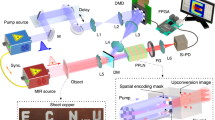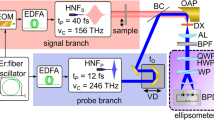Abstract
IN the course of a series of experiments on the propagation of transient stress waves in solids, we have developed an optical method of high-speed recording which does not appear to be described in the literature. The duration of the stress pulses is often of the order of 50 microsec., and the only feasible method of recording the phenomena optically is to use a stationary-film camera in conjunction with a mirror rotating at high speed, the recording film being fixed on a circular arc the centre of which lies on the axis of the mirror. If the radius of this arc is 27 cm., a writing speed of 3 mm. per microsec. (measured on the film) will be obtained when the mirror rotates at 1,000 rev. per sec. Rotational speeds of this order of magnitude can be obtained most easily by means of the high-speed air turbines developed for ultracentrifuge work1, and, in our camera, the rotating mirror consists of an octagonal, stainless steel mirror mounted on the rotor of a small turbine of this type.
This is a preview of subscription content, access via your institution
Access options
Subscribe to this journal
Receive 51 print issues and online access
$199.00 per year
only $3.90 per issue
Buy this article
- Purchase on SpringerLink
- Instant access to full article PDF
Prices may be subject to local taxes which are calculated during checkout
Similar content being viewed by others
References
See, for example, Beams, J. W., “Reports on Progress in Physics", 8, 31 (1941).
Davies, R. M., Phil. Trans. Roy. Soc., A, 240, 375 (1948).
Author information
Authors and Affiliations
Rights and permissions
About this article
Cite this article
OWEN, J., DAVIES, R. High-Speed Recording by a Rotating-Mirror Method. Nature 164, 752 (1949). https://doi.org/10.1038/164752a0
Issue date:
DOI: https://doi.org/10.1038/164752a0



